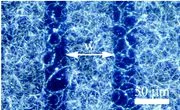Nanowire LEDs show great potential for achieving simultaneous high pixel density and high external quantum efficiency. These characteristics are an important part of what is needed in a display used in AR/VR applications. This Display Daily article discusses issues related to fully realizing the potential offered by nanowire LEDs.
Let me start with a few words of background information.
A nanowire based LED resembles a transistor but it consists of an indium-nitride nanowire stretched between two electrodes on top of a silicon substrate. The nanowire is about 2 micrometers high and 10 to 500 nanometers in diameter. When a current is applied to the nanowire, it emits light. Typically, light in LEDs is produced by injecting both electrons and holes into an active material. With a nanowire LED, it is only necessary to inject electrons since these cause both electrons and holes to form locally, inside the nanowires. This mechanism can be more efficient than that found in conventional LEDs because a single electron can be used to generate more than one electron-hole pair. In addition, nanowires can emit light with higher intensity than conventional LEDs.
Nanowire based LEDs are most efficiently constructed in a so called core-shell configuration. The inner core might be made of gallium nitride (GaN) and a layer of indium-gallium-nitride (InGaN) might make up the outside shell. The reason that a radial stack is the preferred configuration of the different materials in the hetero-junction diode structure is that it gives a large effective emitting area with a small device footprint.
The good news is that the emission wavelength of InGaN/GaN nanowire LED can be tuned by modifying the nanowire diameter. The problem is that doing so causes mismatched angular distributions between blue, green and red nanowires light emission patterns in the far-field. This effect is due to the excitation of different waveguide modes and leads to a noticeable angular color shift. The problem is illustrated in the figure below.

The problem related to having different angular emissions is compounded by the fact that the accepting cone in AR/VR devices is set by the light engine imaging system. The acceptance cone is typically within ±20° due to the small etendue of the pupil in the human eye. As a consequence, the geometry of the nanowires need to be simultaneously optimized to achieve matched radiation patterns for the three primary colors, for high light extraction efficiency and for narrow angular luminance distribution.
A team of researchers headed by Yizhou Qian of the College of Optics and Photonics, University of Central Florida (Orlando, FL) of CREOL has undertaken research to address these issues.
As explained in detail in their article, the approach adopted by the team was based on optimizing the InGaN/GaN nanowire LED geometry by a method called “3D dipole cloud.” The optimization was accomplished by use of a commercial wave optics simulation software product called Finite-Difference Time-Domain developed and sold by Ansys Inc. As part of the optimization process, the team utilized a “multicolor hexagonal single InGaN/GaN dot-in-nanowire LED model” based on previously published experimental results.
A recent article on this topic by the team is entitled “Directional high-efficiency nanowire LEDs with reduced angular color shift for AR and VR displays.” It was published in Opto-Electronic Science, 2022 Vol. 1, No. 12, 220021.
Further details of the team’s approach included the following.
Experimental data was collected. The team “set a 3D large box monitor and small box monitor to calculate the emission power and dipole power, respectively, which defines the light extraction efficiency by their ratio.” Additionally, the far field distribution map was captured by a 2D power monitor placed above the structure. The next steps were as follows:
- First, the nanowire’s angular distribution results from 2D dipole cloud simulation was matched with measurement and compare with traditional central dipole simulation method to validate the accuracy of the model.
- Second, was a calculation and analysis of the radiation pattern, color gamut, angular color shift and light extraction efficiency of full color InGaN/GaN nanowire LEDs by 3D dipole cloud.
- Third was the optimization of the nanowire LED by geometrical engineering.
After optimization:
- The angular color shift within the ±20° viewing cone was found to be consistently lower than the human eye’s just noticeable difference
- The angular full width at half maximum of [blue, green, red] nanowire LEDs was reduced from [48°, 47°, 35°] to [37°, 33°, 24°]
- The effective light extraction efficiency of red, green and blue nanowire LEDs increased by 7.8%, 36.2%, and 7.4%, respectively.
The team concluded their article with the statement that “we have optimized full color InGaN/GaN nanowire LEDs for AR/VR applications by 3D dipole cloud simulation. The simulation method is validated by matching with previous experimental data.”

